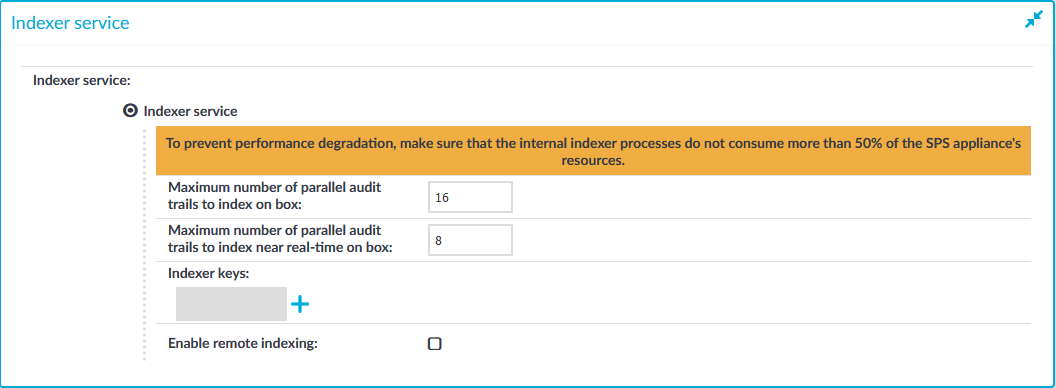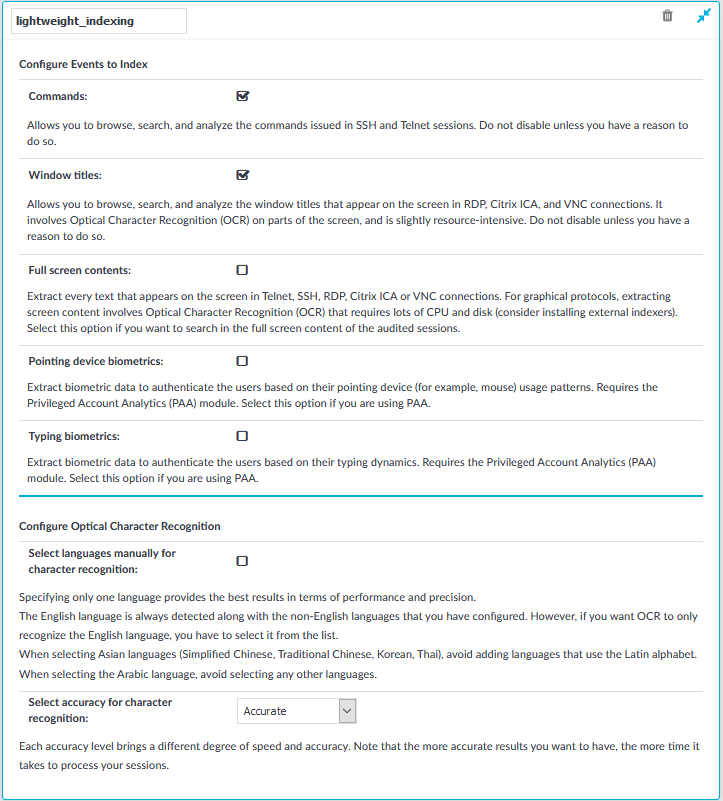-
Navigate to Basic Settings > Local Services > Indexer service.
Figure 262: Basic Settings > Local Services > Indexer service > Configure the Indexer service of SPS

-
Define the Maximum number of parallel audit trails to index on box.
This option determines the maximum number of parallel indexing tasks that the SPS appliance performs. The default value is set to the number of detected CPU cores. Note that indexing audit trails requires about 50-100 Mbytes of memory for terminal sessions (SSH, Telnet, TN3270), and 150-300 Mbytes for graphical sessions (RDP, ICA, VNC, X11). Consider the memory usage of your SPS host before modifying this value.
-
Define the Maximum number of parallel audit trails to index near real-time on box.
This option determines the maximum number of parallel indexing tasks that the SPS appliance performs near real-time, meaning that indexing starts when sessions are still ongoing. The default value is set to 0.
NOTE: A connection policy configured with near real-time priority (Connection policy > Enable indexing > Priority) requires that you set Maximum number of parallel audit trails to index near real-time on box to a value other than 0.
-
(Optional) If you have encrypted audit trails and you want to index them, upload the necessary RSA private keys.
Click  , and then click the
, and then click the  icon to upload a private key. A pop-up window is displayed.
icon to upload a private key. A pop-up window is displayed.
Select Browse, select the file containing the private key, provide the Password if the key is password-protected, and click Upload. Alternatively, you can also copy-paste the private key into the Key field, provide the Password there, and click Set.
TIP: If you want to search in the trail content on the web interface: to view screenshots generated from encrypted audit trails, you also have to upload the necessary private encryption keys to your audit keystore. For more information, see Audit keystore.
-
Click  .
.
-
Navigate to Policies > Indexer Policies.
-
Two Indexer Policies are available by default, both with automatic language detection:
-
full_indexing: Slower, indexes the complete content of the screen, including all events.
-
lightweight_indexing: Significantly faster, but it extracts only the executed commands (Command event) and the window titles (Window title event) that appear on the screen. It does not index any other screen content (for example, text that is displayed in a terminal or that appears in an RDP window).
For example, in the case of an SSH protocol, lightweight_indexing will index a command with parameters, such as cat --help, but will not index terminal printouts such as the help content itself.
When you add a new Connection Policy, the lightweight_indexing Indexer Policy is assigned to it by default.
NOTE: In the case of graphical protocols, the default Optical Character Recognition (OCR) configuration is automatic language detection. This means that the OCR engine will attempt to detect the languages of the indexed audit trails automatically. However, if you know in advance what language(s) will be used, create a new Indexer Policy.
To create a new Indexer Policy, click  .
.
Figure 263: Policies > Indexer Policies > Indexing options and manual language selection

-
Select from the indexing options as follows:
-
Commands: Allows you to browse, search, and analyze the commands issued in SSH and Telnet sessions.
|

|
Caution:
Do not disable unless you have a reason to do so. |
-
Window titles: Text appearing as window titles that can be detected on the screen in RDP, Citrix ICA, and VNC connections. Window title detection involves Optical Character Recognition (OCR) on parts of the screen, and can be slightly resource-intensive. SPS versions up till 6.2 only detected only the active window in the screen. From SPS version 6.3, multiple windows can be detected.
Limitations
-
Default Windows themes are supported.
-
Windows that do not have an X (close window) button in the top-right corner (or it is not visible) are not detected.
-
Use window title detection for sessions that use a single monitor. The feature works in multi-monitor environments as well, but becomes very slow, therefore it is not recommended.
-
Window title detection is case-insensitive.
|

|
Caution:
Do not disable unless you have a reason to do so. |
-
Full screen contents: Select this option if you want to search in the full screen content of the audited sessions.
Extract every text that appears on the screen in Telnet, SSH, RDP, Citrix ICA or VNC connections. For graphical protocols, extracting screen content involves Optical Character Recognition (OCR) that requires lots of CPU and disk (consider installing external indexers).
-
Pointing device biometrics: Select this option only if you are using One Identity Safeguard for Privileged Analytics (SPA)).
Extract biometric data to authenticate the users based on their pointing device (for example, mouse) usage patterns. SPA can analyze mouse movement patterns of your users as a biometric identity verification method to protect against account theft.
-
Typing biometrics: Select this option only if you are using One Identity Safeguard for Privileged Analytics (SPA)).
Extract biometric data to authenticate the users based on their typing dynamics. SPA can analyze the typing patterns of your users as a biometric identity verification method to protect against account theft.
-
To configure what languages to detect, select Select languages manually for character recognition. Select the language(s) to detect. Note the following:
-
Specifying only one language provides the best results in terms of performance and precision.
-
The English language is always detected along with the non-English languages that you have configured. However, if you want the OCR to only recognize the English language, you have to select it from the list of languages.
-
There are certain limitations in the OCR engine when recognizing languages with very different character sets. For this reason, consider the following:
-
When selecting Asian languages (Simplified Chinese, Traditional Chinese, Korean), avoid adding languages that use the Latin alphabet.
-
When selecting the Arabic language, avoid selecting any other languages.
-
The Thai language is currently not supported. If you are interested in using SPS to index Thai texts, contact our Sales Team.
-
Specify an accuracy level for Optical Character Recognition (OCR). Each accuracy level brings a different degree of speed and accuracy:
-
Fast: The fastest option with potentially less accurate results. Select this option if speed is more important to you than getting the most accurate results possible.
-
Balanced (default setting): Fairly accurate option with less than optimum speed. Select this option if you want results to be fairly accurate but you have more than a few sessions to process and processing time is less of a concern.
-
Accurate: The most accurate option with less optimal speed. Select this option if you must have the most accurate results possible and speed is less important or you only have a few sessions to process.
-
Configure the Indexing policy for the Connection policy that you want to index:
By default, the lightweight_indexing Indexing policy is enabled for every Connection policy with normal priority. If this is ideal for you, skip this step and continue with the next step. If you want to use a different policy, for example because you want to OCR the complete screen content, or because you have created a language-specific indexer policy, complete the following substeps.
-
Navigate to the Control > Connections page of the traffic type (for example SSH Control), and select the connection policy to index.
-
Figure 264: <Protocol name> Control > Connections > Enable indexing — Select Indexing Policy

Select the Indexing Policy to be used. Both built-in Indexer Policies feature automatic language detection. To specify a particular language detection configuration, select the Indexing Policy you have created before (in Step 6).
-
To determine the priority level of indexing this connection, select the appropriate Priority level. Selecting a high priority level means that the trails of this connection will be indexed first. Selecting a low priority level means that the trails of this connection will be indexed also, but there might be a delay in indexing if there are a lot of high-priority connections waiting to be indexed. Selecting near real-time means that the indexing of sessions starts when sessions are still ongoing.
-
Click  .
.
-
Check which channel policy is used in the connection, and navigate to the <Protocol name> Control > Connections page. Select the channel policy used in the connection to index.
-
On the <Protocol name> Control > Channel Policies page, verify that the Record audit trail option is selected for the channels you want to index (for example, the Session shell channel in SSH, or the Drawing channel in RDP).
-
Click  .
.
TIP: To verify that indexing works as configured, start a session that uses this connection policy (connect from a client to a server).
When the session is finished, navigate to the Indexer > Indexer status page to verify that the indexer service is processing the audit trail.
If the audit trails are encrypted, ensure that the required decryption keys have been uploaded to Basic Settings > Local Services > Indexer service > Indexer keys.


 , and then click the
, and then click the  icon to upload a private key. A pop-up window is displayed.
icon to upload a private key. A pop-up window is displayed. .
.

